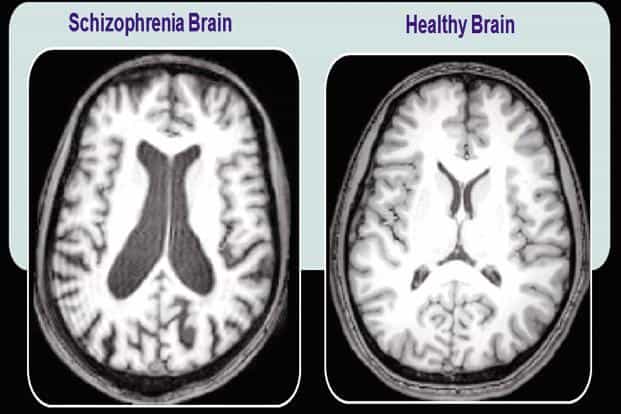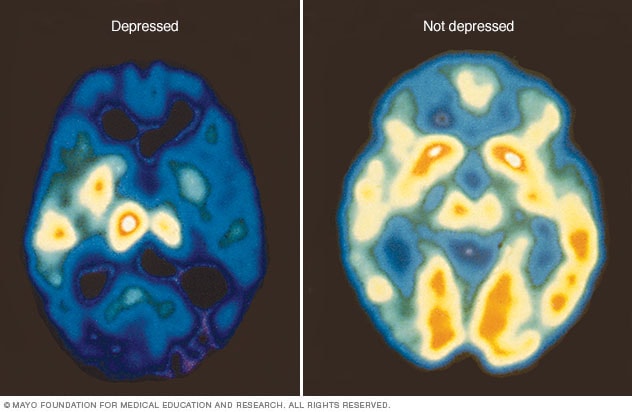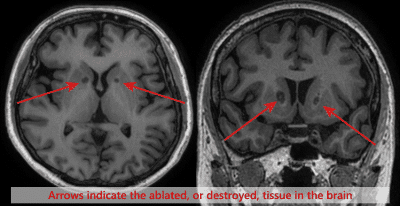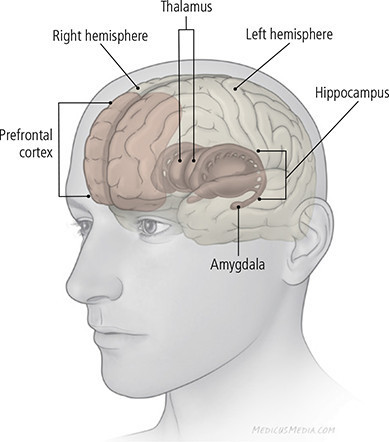The Effect of Mental Illness on Brain Structure
Grade 9
Presentation
No video provided
Problem
We are trying to figure out more about how different mental disorders affect the brain. Backround information on them and how they evolve and affect the peoples daily lives.
Method
For our research project, we would start by choosing questions with significant meaning about each mental illness that would provide sufficient information. We would then find a repuatable website to help us understand the topic. We also found that picturs of the different parts of the brain were quite useful. We could learn about what each part does and where it is located. With different conditions, these parts are affected in different ways and cause the different symptoms. CT scans are also used as we compare on from a "normal" brain and a brain that has one of the different mental illness.
Research
Schizophrenia:
What it is: Schizophrenia is a chronic mental disorder that affects the way the people feel things, see things, and hear noises. It can create hallucinations and delusions of things that other people can not view.
How does it affect the brain:
People who are affected by schizophrenia have thinner cortexes than people without the illness. There is a largest difference in the frontal lobe and temporal lobes.
Frontal lobe: This is one out of the 5 different lobes and is responsible for thinking and making responsible decisions. It helps learn and recall info, attention span, voluntary muscle movements, and social understanding. It is very important and it is responsible for the most important things like how you talk and behave.
What is it made of: Neurons are cells in your brain that send impulses through other neurons that travel as electricity. The neurons can convert the electrical energy into chemicals. Because of this. Messages can quickly travel across different neurons.
Positive symptoms- symptoms that only occur to the population that have schizophrenia. Things like hallucinations, hearing things, delusions, disordered speech and behavior.
Negative symptoms- Qualities that are reduced by people with this disease. Things like wanting to talk, motivation, expression of emotion,
Cognition symptoms- remembering important things and remembering to do things, difficulty concentrating,
Its a common misconception that people with schizophrenia have multiple personalities but this is untrue as these symptoms indicate a disruption in one's thought process.
What causes this psychosis????
There isn't just one single cause that causes this; there are multiple genetic and environmental risk factors that are included. Schizophrenia has one of the strongest genetic links than any other mental disease. Children or siblings of people with schizophrenia are ten times more likely to get it. People with an identical twin who has schizophrenia are forty times more likely.
Environmental factors as well like exposure to certain diseases in early infancy may increase the chance. Use of some drugs can also increase the chance such as marijuana in early onset in susceptible individuals. These factors do not affect everything in the same way. Those with a very low genetic factor will not be affected by the disease from the environmental factors.
Depression:
What it is: Depression, also known as major depressive disorder, is a common mental disorder. It causes a persistent feeling of sadness. Depression can also make people feel a loss of interest in activities. Depression can lead to a variety of emotional and physical issues which can affect a person in the long run. Depression can cause suicidal thoughts, body dysmorphia and other severe side effects. It may require long term treatment.
- Reduced gray matter (The outer layer of the brain. Sensation, perception, learning, speech, cognition all take place in the gray matter of the brain. When this is reduced, it makes everyday life extremely difficult. Gray matter takes up about 40% of your entire brain.)
- Neurotransmitter disruptions (Neurotransmitters are your body's chemical messengers. Neurotransmitters carry messages from one nerve cell across a space to the next nerve, muscle, or gland cell.)
- Inflammation of the brain (Causes brain to swell. Headaches, stiff neck, seizures.)
- Memory issues and loss
- Reduced attention and concentration
- Lower processing speed
- Increase of blue and green colours / decreased white and yellow shows decreased brain activity.
Bipolar Disorder: Bipolar disorder is a mental health condition that causes extreme mood swings, including emotional highs also known as mania or hypomania, Emotional lows, also known as depression, are also caused.
Hypomania - a condition in which you display a revved up energy or activity level, mood or behavior. The new “energized you” is recognized by others as beyond your usual self.
Bipolar disease has certain impacts on specific structures of the brain. The most notable being:
-
The prefrontal cortex. This part of the brain directly effects mood related disorders. It is also responsible for cognitive control (the ability to control and moderate ones behaviour), impulsivity (behaving without thinking and without realizing the risk involved in the behaviour), and attention.
-
Gray matter. Much like depression, gray matter is affected.
-
Temporal cortex (Affecting parts of the brain responsible for being able to regulate your emotions, attentions span, decision making, memory, which results in extreme mood swings.)
PTSD:
What is it: Post Traumatic Stress disorder
Post-traumatic stress disorder (PTSD) is a mental health condition that's caused by an extremely stressful or terrifying event — either being part of it or witnessing it. Symptoms may include flashbacks, nightmares, severe anxiety and uncontrollable thoughts about the event. -Mayo clinic
Causes: PTSD is caused from a very traumatic experience that affects one in their daily lives. Really the only cause would be the event that was extremely traumatic.
- Childhood physical abuse.
- Sexual violence.
- Physical assault.
- Being threatened with a weapon.
- An accident.
- Combat exposure
All things that can lead to PTSD
How does it affect the brain:
Your Alarm system:
The amygdala acts like your alarm system. If there is an event happening that can cause harm it sends a signal that causes fear response. It makes sense as it helps to keep you safe when it triggers this. Although, people with PTSD are overactive so hearing anything as simple as a car horn can trigger a fear response. This part in your brain is very important and when it is overactive it is hard to think rationally.
Your Brake system:
The prefrontal cortex( frontmost part of the neocortex) is the part that helps your through decision making. It observes thinking processes and puts the brakes when you realize a fear isn't as bad as first perceived. It regulates emotional response triggered from the amygdala but people with PTSD, often this part struggles to do its job properly.
Bad combination:
A storm is created when an overactive amygdala and underactive prefrontal cortex are paired together. It can be compared to hitting the gas pedal on one's car for no reason only to discover the brakes don’t work. This can explain a lot of things that go on with people experiencing PTSD such as having fear over something that is not nearly as bad. Or getting extremely anxious in places that remind them of their trauma. And why many people aim to avoid those kinds of situations that can provoke those feelings.
System recall errors:
Other common experiences that people with PTSD may encounter is constantly having unwanted feeling and thoughts about the event. This can be related to the hippocampus which is the memory center of the brain. Sometimes people can struggle to recall certain information about their experience because of the extreme stress it causes it might not get coded correctly. This causes the hippocampus to continue to think about the event in order to try and further understand and get more details.
Overall, the amygdala, the prefrontal cortex, and the hippocampus are all parts of the brain that are affected by PTSD and largly contribute to the different symptons that people experience when affected.
Data
Schozophrenia:
People with this mental disorder often have thinner cortextes
When someone has schozophrenia there is often a imbalance of certain chemicals that cause the symptoms. Dopamine is something that is related to hallucinations and delusions. This is beacuse the areas that need dopanice to function can often become overactive.
The frontal lobe is also affected which is responsible for important things like memory, motor skills, judgment. The temproal lobe is tied to emotions. Those lobes often have the largest difference than brains without the condition. Studies have shown that people have much smaller forntal regions and thalamus.
White matter is also affected as it is responsible for connecting different regions of the brain and sharing information. Studies have shown that people with schizophrenia have reduced white matter in their brain.

https://www.amberusa.com/blog/brain-can-reverse-signs-of-schizophrenia-mri-studies-show/
In a recent strudy conducted by Robart Reserch Institute 98 people with shizophrenia and 83 without pere involved. They found that there was a lot less brain tissue in many parts of the brain for people with schizophrenia. Further into the study they discovered that in smaller regions there is a decrease in brain tissue.
Depression:
On a chemical level neurotransmitters are affected. These transmitters are used to carry messages across the brain to cells and neurons.

A PET scan can compare brain activity during periods of depression (left) with normal brain activity (right). An increase of blue and green colors, along with decreased white and yellow areas, shows decreased brain activity due to depression.-- The Mayo Clinic
This shows us that depression affects the amount of brain activity that goes on.

https://www.amberusa.com/blog/fighting-depression-with-non-invasive-ultrasound/

The amygdala is an affected area of the brain for people with depression. It controls all emotion like happiness, sadness, sorrow, fear, pleasure or anger. The activity in the amygdala is often increased which may also lead to an enlargment of the amygdala.
The Hippocampus is also affected as it is the part of the brain that is long-term mmemory. It works with the amygdala to help remember past experiences and become more catious. An example could be is if a person had a bad encounter with aggressive dogs and later on life, they hear a dog barking, the hippocampus would trigger and make them more catious and scared. The hippocampus is often seen as smaller in people with depression and some reachered leads to the idea that ongoing exposure to stress hormones may impair the growth of neurons in that section of the brain.
https://www.health.harvard.edu/mind-and-mood/what-causes-depression
Bipolar Disorder-
One way that the brain is affected with bipolar disorder is through chemical imbalances of neurotransmitters. This is what can cause the symptoms of delusions, hallucinations, and changes in thinking.
There are also some structual changes in the brain as most experts beileve that experience a size reduction. The hippocampus, prefrontal cortex and gray matter are all affected areas of the brain.
Hippocampus- Plays a role in emotions and a persons memory.
Prefrontal cortex- Is responsible for cognitive control, impulsivity, and and attention and has an important role in many mood related disorders.
Gray matter- Gray matter is what processes the information given. It can be important for movement, emotions and memory as well as it sits in the outermost part of the brain.
People with this disorder were found do have much less gray matter volume. Gray matter helps us humans in every aspect of our life and is very crucial for us functining properly. The areas affected are related to why the people have such changes in their moods and actions.
The hippocampus was also found to be much smaller. A study was conducted in 2017, https://www.nature.com/articles/mp2016262.epdf?author_access_token=WpXUsTmfd2m9HF0TGi0L89RgN0jAjWel9jnR3ZoTv0ONqXBiU0LglZPZ-1rbdtmK7PpSMANWP7p6Y28tDLlCyJ0XRlXRS_WZt2tGIDwQdTrCd-s-RQApIAYBRKJ52JCQ that involved 152 people without mood disorders, 133 will biporlar, and 86 with major depressive disorder. MRI scans revealed that people with bipolar disorder and smaller hippocampuses that the other two groups of people.
https://www.medicalnewstoday.com/articles/bipolar-disorder-and-the-brain#affected-structures
The three neurotransmitters that are affected are dopamine, serotonin, and noropinephrine.
Some scientists still are unsure if all of these sysmptoms are caused from the disorder it self or is what is causing it.
PTSD:
People with PTSD have overreactive Amygdala and underreactive Prefrontal Cortex and when those two are together they cause the majority of the symptoms. The Hippocampus also plays a role as it gets confised when processing the experice that casue PTSD and can lead to the person thinking more and more about it as it trys to figure out the smaller missing details.
Conclusion
Schozophrenia:
Overall, we have learned that people with this disorder have halucinations, delusions, and can hear things that others can't. We have learned that there are many different causes to this such as genetic links, as well as other enviromental factors such as different drugs. The brain is affected by often having thinner cortexes, as well as chemical imbalace as dopamine is related to the symptoms of halucinations. The frontal is also affected as well as much smaller frontal regions and thalamus. People will often have reduced white matter in their brain as it is responsible to sharing information.
Depression:
Overall, we have learned that depression is extreme prolonged sadness in someone sometimes leading to a loss in interest for activities, suicidal thoughts, body dysmorphia and others. We know thatv neurotransmitters are affected that are used to carry signals. The amygdala is also an affected part that is responsible for emotions, fears. Activity is often increased in that area. The hippocampus is also affected which is the long term memory section. Past scary experiences can haunt these people in later activities and contribute to the symptoms.
Bipolar disorder:
We have learned that Bipolar disorder is when someone experiences extreme mood changes and emotional highs also known as hypomania. We also know that the three things affected are the hippocampus, prefrontal cortex and gray matter. As well as some neurotransmitters are affected including dopamine, serotonin, and noropinephrine.
PTSD
People with PTSD have overreactive Amygdala and underreactive Prefrontal Cortex and when those two are together they cause the majority of the symptoms. The Hippocampus also plays a role as it gets confised when processing the experice that casue PTSD and can lead to the person thinking more and more about it as it trys to figure out the smaller missing details.
Citations
Ted-Ed Video
Medicalnewtoday.com
https://www.mayoclinic.org/diseases-conditions/depression/symptoms-causes/syc-20356007
clevlelandclinic.org
https://my.clevelandclinic.org/health/body/24831-grey-matter
https://www.spinalcord.com/blog/gray-matter-vs-white-matter-in-the-brain
https://www.mayoclinic.org/diseases-conditions/bipolar-disorder/symptoms-causes/syc-20355955
https://www.medicalnewstoday.com/articles/bipolar-disorder-and-the-brain
Brainline.org
https://www.webmd.com/schizophrenia/schizophrenia-and-your-brain
https://www.hopkinsmedicine.org/health/conditions-and-diseases/schizophrenia
https://www.yalemedicine.org/news/neurobiology-depression
https://www.health.harvard.edu/mind-and-mood/what-causes-depression
https://www.medicalnewstoday.com/articles/bipolar-disorder-and-the-brain#affected-structures
Acknowledgement
We want to thank everyone that has helped us throughout this project. Our two teachers Mr. Greaves and Mr. Lappin. As well as Tanbridge academy for showing us this oppurtonity. Lastly, thank you CYSF for providing this oppurtonity to us to learn more about something in our world that interests us and present it.

